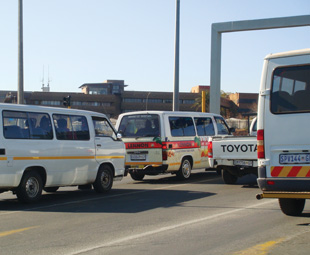Taxi to Africa!

It is estimated that minibus taxis account for 70 percent of modal share in the cross-border road-transport industry, within the Southern African Development Community (SADC) region. So yes, they do perform an essential service, but it’s not without its challenges …
The minibus-taxi industry in South Africa has grown from a negligible informal sector activity in townships, to be a dominant mode of public transport. However, the fact that minibus taxis have limited carrying capacity, yet they travel such long distances per trip, raises key questions with regard to the sustainability, viability, cost-effectiveness and productivity of cross-border operations. Furthermore, it also raises questions about safety of services; given that minibuses are driven by one driver over such long distances.
Background
The cross-border minibus-taxi service is defined as a service for the conveyance of passengers, rendered by means of a motor vehicle with a carrying capacity of not less than nine persons and not more than 16 persons, including the driver, with no prescribed timetable or fares. The majority of these minibus taxis are not owner driven; they officially carry a driver and 15 passengers.
Meanwhile, passenger transport in South Africa – just like in many other developing countries – has many characteristics that are generally absent from the public-transport systems in the first-world countries.
The first and prime characteristic is the high volume of low-capacity vehicles (less than 20 seats) in commuter services, and the dominance of this form of public transport in the overall public-transport sphere.
Research
In order to gain an understanding of this sector, a study entitled: Market Access Regulation was conducted by the Cross-Border Road Transport Agency (C-BRTA) in partnership with the Centre for Scientific and Industrial Research (CSIR). The quantitative component of the study comprised field surveys that were undertaken to establish the peak and off-peak travel demand profiles and peak and off-peak cross-border service profiles.
The peak and off-peak travel demand profiling surveys were carried out at Beitbridge, Lebombo, Oshoek and Mahamba border posts (on the South African side). The surveys entailed interviewing a sample of passengers who were entering and exiting South Africa to establish elements such as: reasons for travelling, frequency of travel, travel costs, trip origins and destinations.
In addition to the passenger interviews, the surveys included 24-hour vehicle occupancy counts for vehicles entering and leaving South Africa, including number plate observations for public-transport vehicles. The dates of the surveys were carefully selected to capture the peak and off-peak dynamics.
Fascinating findings
The minibus-taxi industry has displayed great levels of resilience and innovation in the face of shifting political and socio-economic conditions and has become the dominant mode of public transport in South Africa. However, the industry is plagued with violence, poor road safety and low financial margins.
 These are the major concerns affecting cross-border minibus-taxi operations between South Africa and other SADC countries:
These are the major concerns affecting cross-border minibus-taxi operations between South Africa and other SADC countries:
• Minibus taxis have limited carrying capacity, yet
they are travelling long distances between countries (in most cases the distances are longer than
1 000 km a single trip). This affects the sustainability, viability, cost-effectiveness and productivity of the operations;
• The fact that there is only one driver assigned to a minibus, raises questions about the safety of services;
• Many minibus operators regularly overload trailers to recover the loss due to unoccupied seats, fixed costs related to the vehicle and semi-variable costs related to the vehicle and driver;
• Sometimes luggage is mixed with passengers, which does not only reduce passenger comfort, but also potentially reduces safety.
Productivity challenges
While the cost of operating a minibus taxi is lower when compared to a standard bus, so, too, is the revenue per kilometre. This effectively reduces the viability, sustainability and productivity of minibus-taxi operations in the cross-border road transport environment.
Profitability woes
The low profitability of minibus-taxi operations is creating an impediment on the day-to-day performance of the industry, as it influences maintenance of vehicles, quality of vehicle purchased, as well as drivers’ salaries.
It leads to owners deferring, or even ignoring, essential maintenance, the use of cheap and inferior vehicle parts alongside services undertaken by unqualified mechanics, which further result in the deterioration of overall condition of the industry’s minibus taxi fleet.
Inadequate financial management is another reason for the low profitability prevalent within the cross-border minibus-taxi industry. Research on the economic role of the minibus-taxi industry revealed that owners are commonly unfamiliar with concepts such as profit, budgets, depreciation and return on investment. The same can be argued in the case of the minibus-taxi industry in the cross-border environment.
What is needed?
Minibus-taxi operators should consider replacing minibuses with higher-capacity vehicles (midibus and buses) for cross-border operations. The cost of transporting one passenger in a cross-border passenger service may decrease considerably as the vehicle size increases.
For instance, by going from a 16-seater minibus to a 35-seater midibus, or 64-seater bus the number of seats may be doubled, or be four times higher, but the labour costs and the vehicle operating costs do not multiply at the same rate. Thus, significant reduction in unit costs may be achieved at maximum vehicle performance, while ensuring unbeatable comfort and improvement in safety through larger, high-capacity vehicles.
Funding should be mobilised for cross-border minibus operators to procure high-capacity vehicles. This would go a long way towards enhancing profitability, productivity, viability and sustainability.
Minibus-taxi operators need to be supported in order to improve the management of their operations and their businesses in general.
Regulatory authorities in the respective SADC countries should investigate and implement measures to address oversaturation in the minibus-taxi industry on some routes.
Regulatory authorities should also consider prioritising the issuing of permits to buses for cross-border operations for long distances, as, in principle, they are more efficient than small low-capacity vehicles.
Finally, regulatory authorities should regularly consult one another before granting cross-border permits to minibus-taxi operators in order to ensure that permits are issued only where and when there is sufficient demand.
This article is based on a paper entitled: “An Analysis of South African Long Distance Passenger Transport: Cross-Border Passenger Movements”, which was presented by Makibinyane Thoso and Etiyel Chibira from the Cross-Border Road Transport Agency at the 2016 Southern African Transport Conference.
Published by
Focus on Transport
focusmagsa




